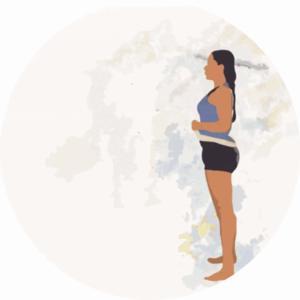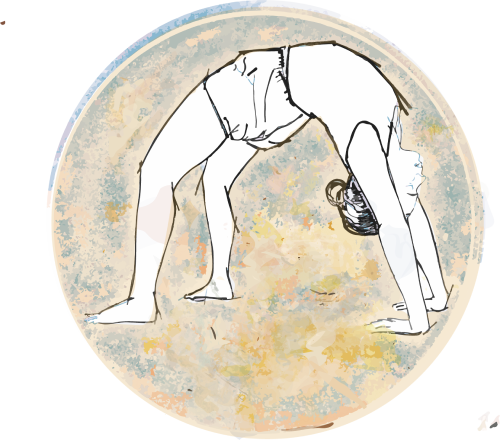[vc_row][vc_column][vc_column_text]We live in a fast-changing world. What would at one time, sounded almost sacrilegious, is now a reality: finding an online teacher for learning yoga.
This is the transcript of a video broadcast that we share with those considering an online learning platform for yoga – either with us – or elsewhere.
we put these pointers together as instructors, but more importantly, as students ourselves.
These are practical tips valid at any time at any time, but especially relevant when you are learning remotely, without direct supervision, or close proximity with a teacher.
This broadcast is in two parts.
For those looking for an immediate ‘call to action’, the first part is simple list of ‘good practices’
The second part takes a step back to look a the sources from where this list has been drawn.
Part 1: Suggestions for getting the most of a self-directed practice:
– choose your time of practice and stick to it as much as possible
– don’t do an activating and energising practice very close to sleeping time.
– try to create a clean environment for your practice. it can become a personal sanctuary in a tumultuous world. It need not be a large space. even if it a corner of your home, see if you can set it aside for this purpose,
– if possible, clean this space yourself, install a picture or a symbol of divinity that you trust.
– commence your practice after a bath or a wash, with a purificatory gesture like offering prayers for an auspicious beginning.
– spend some offline time reflecting about your online sessions — make notes the old-fashioned way, and work with your notes. If going back to practice the same online session a second time, maybe you can cut out the visuals, and just listen to the audio instructions.
– there have always been many teachers and many traditions of yoga in the real world. And now there are many options for online learning. find one that is well rounded enough to strengthen and sustain you, that makes possible steady progress. a very activating physical practice might show physical gains, but is likely to leave you feeling anxious and tired in the long run. Similarly, a very slow practice always might give the illusion of relaxation, but will not energise you, and will ultimately leave you feeling mentally and physically dull and sluggish.
– if you do not have the right props or enough props, acquire them slowly over a period of time, and meanwhile enjoy the creativity in making do with what you have.
the two most important Approach Guidelines:
– in your practice, value consistency over intensity – always. long-term gains require steady, sustained efforts.
– work with a keen sense of exploration and observation. since there isn’t anyone to correct your mistakes, the only option is to become aware of these mistakes as quickly as possible. this requires your absolute honesty in observation. the sensitivity and intelligence will develop as the practice matures.
-use your eyes – look at your actions keenly – your arms, legs.
– use your own hands and to touch, feel and position your body
– experiment experiment experiment – if you are given three options to do a particular action, try all 3 of them.
for example, in our sessions, when we are doing seated positions, we often ask people to choose the most appropriate height to sit on – it could be just an inch ( a single folded blanket), 5-6 inches ( a bolster or 2-3 folded blankets), or directly on the floor. In a live class, we would look at a student’s posture and advise them on which is the best support for them. but when working independently, this is something the student has to decide for themselves. and the only way to take that decision, is to try out all the options – even if one feel ‘comfort’ with the first option, try the 2nd, and the 3rd.
– the last tip might not sound very practical, but is very important for our own peace of mind: work with a sense of renunciation and surrender.
————————
Part 2
These practical tips are derived from classical traditions – the Aurveda and the yoga traditions.
The concept of ones ‘NATURE, or prakruthi, is central to ayurveda – it defines our physiology and psychology, and gives us a blueprint to lead a healthy life.
Prakruthi is determined by a combination of the three doshas – Vata, Pitta, and Kapha. All of us have have all the three doshas in varying proportions, with one or two predominating. This is not a lecture on Ayurveda, and i would urge all of you to spend some time learning about this. I am going to speak only about one of the dosas that is most relevant here – the VATA dosha.
Vata has the elemental composition of Air and Ether.
Like its constituent elements, Vata has a quality of lightness, space, of mobility, of changeability. In our bodies it powers all movement – of air, of food, of waste material, of menstrual blood and sexual fluids, of nervous impulses, and that most nimble-footed of all – our thoughts. The more gross movements – the kinds that we do in a physical activities, the functioning of joints, all of this is also controlled by Vata.
When Vata in the body is in a state of balance, it gives us a positive outlook to life, make us creative and enthusiastic. But the lightness of Vata also makes it the most susceptible to derangement. In fact, the ancient Acharyas of Ayurveda had predicted, that Vata related derangement will be responsible for half the disease conditions of our times. what do these data induced derangements look like? all too familiar, i am afraid!. When Vata is aggravated, it manifests in all levels – mental, emotional and physiological. dryness of skin and hair, aches and pains in joints, bloating and constipation, menstrual disorders, anxiety, nervousness, sleeplesness.
There are things and activities that keep data in check. And there are things and activities that throw Vata out of whack. lets look at the most important of these
the first – Vata like regularity – a regular routine – primarily of eating, sleeping and waking up – at the recommended times – is the most important.
the second – what we consume – food for the body – Vata is disturbed by excessive consumption of dry, processed foods, intoxicants and stimulants and extreme forms of diets.
the third – what we consume – food for the mind – excessive stimulation of the senses. And the biggest culprit for this these days is electronic gadgets. working long hours on computers and mobile phone – either for work, or recreation, or learning has become almost seance nature for many of us, to the extent, we don’t even realise the chronic stress this puts our eyes, ears, and our minds.
if we are going to spend a lot of time stimulating your senses by watching yoga tutorials, the effects will be milder, but still of the same nature, as watching say Netflix. This can be a contradiction considering that yoga is supposed to put us in a quiet, sublime neutral state of mind.
——————————
the Yoga sutras can be interpreted by aspirants of all kinds in all ages. We will briefly talk about the Niyama listed in yoga sutra 1.32
The first two concepts of the ashtangic – or eight-fold path of yoga is the yama and the niyamas. While yamas guide our course of behaviour in the external society, Niyamas, offer the coeds of behaviour with respect to ourselves. When embarking on a personal journey, largely self motivated and self-directed – isn’t that really important? to – follow a code of conduct for ourselves.
sauca santosha tapah svadhyaya iswara pranidhanani niyama
5 niyamas have been listed
sauca
santosha
tapas
svadhyaya
and swara pranidhana
this is not a discourse on the yoga sutras, and i am taken some liberties here to reduce these lofty concepts to simplistic guidelines that are relevant to how we practice remotely.
sauca
cleanliness
many of our students tell us that when they step in to the practice room, the idol of Patanjali, the fresh flowers and the incense we burn in front of the idol, the floor that we try to keep clean, the props that we are almost anal about keeping neatly stacked, all of that immediately changes their state of mind. we do put a lot of effort in doing this things, because we realise that these things are very important. these are all elements of cleanliness.
santosa and tapas
Literal translation is contentment. and tapas literal; translation is austerities – we will look at these two together.
the popular translation of austerities for tapas can be misleading. the word itself denotes the taap – or the heat – that is generated as we pit ourselves against our own predispositions. like moving uphill, Its an endeavour, and only through the energy generated by our own efforts is progress possible. But this heat is not an all-consuming heat that will burn bright momentarily, and then burn us down. It is the mellow, slow flame of sustenanace. this is where santosa (contentment) comes in.
remember what we discussed earlier about the qualities of Vata – an aggressive, inconsistent or uni-dimensional asana/ pranayama practice can also disturb this very important Dosha in our body, and leave us in a state of imbalance.
Svadhyaya – the studying of the self.
Yoga is a wonderful and unique subject in that it provides us with ample scope to study all aspects of ourselves. at the physical level, it means paying exquisite attention to the why and how of doing physical actions – even the small ones. But as Mr Iyengar guided us, we can also use our asanas as the laboratory to study not just out bodies, but also the entirety of our selves.
– the yamas and Niyamas themselves can become our subject of study – as they apply to ourselves – how are we doing with sauca, santosa, tapas, svadhyaya, and the Yamas – Ahimsa, satya, astray, brahmacarya and aparigraha.
– this is also why we suggested earlier – once you have got the main point of an online session, if you want to go back to it, consider making notes, consider doing what has been internalised. Bring in the element of svadhyaya in the practice.
Isvara pranidhana means dedicating the fruits of the actions at the feet of divinity.
i will leave you to contemplate the complex question of who this divinity is or should be. but working with a sense of renunciation and surrender is central to the path of yoga, without which much of its lofty results will not be accessed
If you are an absolute beginner, pl know this: finding a good teacher, and being able to study with them closely – can be a life changing experience. We wish for you, and for all aspirants, a wise and kind teacher – in the real world.
Meanwhile, let us know if we can help.
We hope your practice brings you endless adventures, as it has brought for us.[/vc_column_text][/vc_column][/vc_row]



